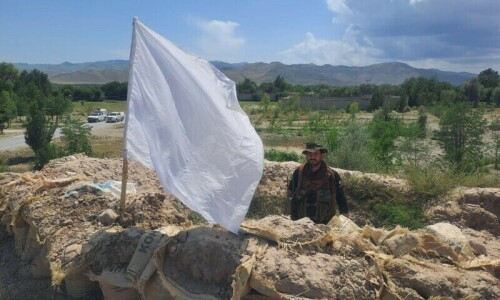
Sukkur and its environs, on the banks of the Indus river, are home to Sufi shrines scattered in the towns of Sukkur, Bukkur, Rohri, Nasirpur and Thatta. This is where the first Suharwardi Sufi saints came to settle in the 13th century. Eminent artist Mussarat Mirza, born in Sukkur in 1946, has been living and painting there since after her Masters in Fine Arts from the Punjab University, Lahore, in 1965-67.
Mirza’s narrative seems firmly anchored within the vastness of an inner source, her references private, her location remote. The journey has naturally created its own path oblivious to artistic trends. She has headed the fine arts department at the University of Sindh in Jamshoro from 1971-99. Regarded as a painter par excellence, Mirza is also a recipient of the Tamgha-e-Imtiaz.
A recently opened retrospective at Koel Art Gallery, titled ‘Har Ja Tu, In the Realm of Light’, is an apt tribute to this artist, whose art remains understudied and relatively peripheral to the dominant art discourse in Pakistan. Sixty selected works from 1958-2021, curated by Maha Malik, give a slice of Mirza’s extensive oeuvre.
Mirza’s has been a solitary sojourn, seeking and living mysticism, in a career spanning six decades. Malik was passionately drawn to Mirza’s narrative. Following two years of archival research, and a friendship going back to 2013, she has brought a stellar show to Karachi.
A remarkable retrospective hosted by Koel Gallery shines a spotlight on underappreciated master artist Musarrat Mirza
In the absence of museums and their production structures, the gallery has taken on the role of hosting the art and facilitating the production of a monograph. The curator’s documentation has made the reading of the art possible. It is now imperative that researchers and academics, as well as writers of art, try to unpack Mirza’s art.

Malik speaks of the journey of searching for connoisseurs of Mirza’s art, and gaining insight from conversations with the individuals who have lent the paintings for the retrospective. Trips made to Sukkur acquainted her with the nuanced form that is Mirza’s signature. Paying haazri [respect] with the artist to the mazaars [shrines] of the Sufi saints Shah Sadruddin Badshah and Syed Hajnah Shah were journeys that developed contextual links to the art. Mirza's devotion to the Sufi saints is deeply linked to her life's journey.
Mirza’s oeuvre is characterised by her subtle atmospheric paintings of the rooftops that she viewed from her home. Rooftops or not, the muted green, blue and ochres are drenched in a magical white. The light seems to emanate from within the form. The compositions have a multi-faceted perspective, and are not simple cityscapes. Angular shadows and lights of sunbathed buildings join to form a circular movement before disappearing into the far distance.
At times, the eye seems suspended over a cluster of buildings, like the soul that has transcended to another realm. A red alam, the flag commemorating the martyrdom of Imam Hussain, watches over Sukkur’s hazy skyline. The city is bound in devotion to the land of Lal Shahbaz Qalandar. The artist’s connection to her painted form is through these intermediaries.
There is incredible affinity between Mirza’s social and spiritual surroundings and empathy towards the land. Perhaps this was the influence of her training at Punjab University, where the tradition of landscape painting had been ingrained. Mirza, however, embarked on a solitary search that was far beyond a realistic rendering of her surroundings. She broke away into abstraction, but retained the essence of the spirituality in relation to land.

It would be worth researching on the nature of Mirza’s modernity, in how the pictorial space is composed, and the majesty of her path. Can the rooftops be viewed as stepping stones in search of a destination, or manzil? Shows such as these are important milestones for younger artists and their mentors, who would otherwise not be able to view the art in this depth or sequence. We can collectively begin to ask questions around the art.
The canvases of the 1980s hold ochres and ambers within dark recesses. There is a melancholic emptiness and, eventually, a move away from a realistic depiction of buildings towards ambiguous, modernist spaces. The muddiness lifts in the 2000s, with a stark clarity, like an awakening. The path is crystal clear, bathed in the poetry of devotion. Like Shah Abdul Latif Bhittai’s poetry, which Mirza was introduced to at an early age, it is a reflection on the human longing to reach a higher level in social life, so as to meet the Creator, Almighty Allah.
As F.S. Aijazuddin writes on Bhittai’s Shah Jo Risalo, that his poetic compilation recognises the power of sound in spiritual practice, or what the aesthete Mughal prince Dara Shikoh called the infinite and absolute sound — the voice of silence — in a similar manner, the poetry emanating from Mirza’s painted form references another station or muqaam — a place of stillness.
‘Har Ja Tu, In the Realm of Light’was exhibited at the Koel Art Gallery from August 27-September 17, 2022
Published in Dawn, EOS, September 18th, 2022













































